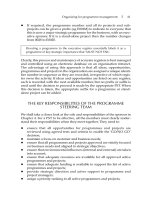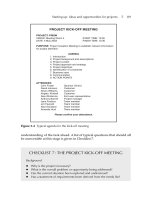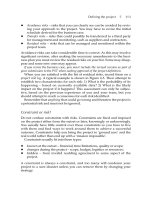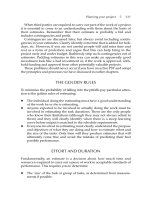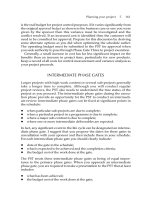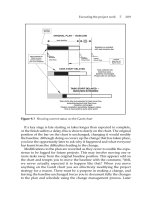Ebook Textbook of histology and a practical guide (2/E): Part 2
Bạn đang xem bản rút gọn của tài liệu. Xem và tải ngay bản đầy đủ của tài liệu tại đây (17.59 MB, 247 trang )
11
INTEGUMENTARY SYSTEM
INTRODUCTION
Integumentary system includes skin and its appendages, namely, hair and nail. Skin covers the surface of the body and comes
into direct contact with the external environment. It is the single heaviest organ of the body forming one-sixth of the total body
weight, and its surface area is 18 sft. On close observation, the external surface of the skin shows many lines such as tension
lines due to anchoring fibrils of dermis, flexure lines over joints and friction ridges (papillary ridges) over palm and sole. The
papillary ridges and the intervening sulci on the palm and sole assume a unique configuration for each individual and is used for
personal identification. The study of these configurations is called dermatoglyphics (finger print) which is an upcoming field and
of considerable medical, anthropological and legal interest. The dry skin becomes continuous with the wet mucous membrane
at various orifices seen on the surface of the body, viz., mouth, nostril, anus, vulva, etc.
FUNCTIONS OF SKIN
Protection: Skin gives protection against mechanical trauma, invasion of microorganisms, evaporation (water loss) and
ultraviolet rays (by melanin pigments).
Sensory perception: Skin is the largest sense organ of the body. It contains many receptors for general sensation (pain,
touch, temperature and pressure).
Thermoregulation: It is mainly performed by glands (sweating) and also by blood vessels and adipose tissue.
Synthesis of vitamin D: Epidermis of skin is involved in synthesis of vitamin D from 7-dehydrocholesterol by the action
of UV light.
Excretion: Skin acts as a minor excretory organ for certain catabolic nitrogenous waste products and water.
Blood pressure regulation: This is done by specialized arteriovenous anastomosis called glomus found in the dermis of
the skin.
Storage: Skin acts as a storehouse for glycogen and cholesterol in the subcutaneous fat.
Absorption: Skin also absorbs certain lipid soluble substances, drugs/chemicals which are of therapeutic value.
Skin is useful in personal identification, especially in criminology—through dermatoglyphics (finger print).
TYPES OF SKIN
There are two types of skin:
1. Thin skin or hairy skin (Fig. 11.1; Box 11.1)
Epidermis is very thin.
Has hair.
Found in all other parts of the body except palm and sole.
2. Thick skin or glabrous skin (Box 11.2)
Epidermis is very thick with a thick layer of stratum corneum.
Has no hair.
Found in palm of hand and sole of foot.
189
190
Textbook of Histology and a Practical Guide
Hair (shaft)
Epidermis
Hair root
Hair follicle
Dermis
Sebaceous
gland
Hair bulb
Arrector
pili muscle
Fig. 11.1
Sweat gland
(secretory part)
Thin skin.
STRUCTURE
Skin is composed of two layers, epidermis and dermis. The epidermis is made of stratified squamous keratinized epithelium, whereas the dermis is made of connective tissue.
The dermo-epidermal junction is not smooth, but uneven due the presence of two sets of ridges interlocking alternately
with one another, viz., epidermal ridges and dermal papillae. These ridges are numerous, tall and often branching in areas
where mechanical demands are high, e.g. palm, sole, nipple, penis, etc.
EPIDERMIS
Is dry epithelium made of stratified squamous keratinized epithelium.
Projects into the dermis as epidermal ridges.
Is ectodermal in origin.
Its thickness varies from 0.1 mm to 1.4 mm.
Is avascular and is nourished by diffusion.
Free nerve endings are seen in its basal layer.
Is mainly made of keratinocytes; other cells are melanocytes, Langerhans cells, Merkel’s cells.
Is renewed every 15–30 days depending on the region of the body, age and other factors.
Integumentary System
Box 11.1
Chapter 11
191
Thin Skin (Hairy Skin).
Presence of
Epidermis
Dermal Papillae
Papillary Layer
of Dermis
Reticular Layer
of Dermis
Sebaceous Gland
Hair Follicle
Sweat Glands
L/P
Thin skin (Hairy skin)
Keratin
Epidermis
Dermal Papilla
Dermis
Connective Tissue
Sheath
Hair Follicle
Hair
Sebaceous Gland
H/P
Thin skin (Hairy skin)
(i) thin epidermis made up of keratinized
stratified squamous epithelium
(stratum corneum is thin);
(ii) hair follicles and sebaceous glands;
(iii)sweat glands in the dermis.
192
Textbook of Histology and a Practical Guide
Box 11.2
Thick/Glabrous Skin
(Nonhairy Skin).
Presence of
Epidermis
Dermis
Sweat Glands
Adipose Tissue
L/P
Thick/glabrous skin (Nonhairy skin)
Stratum corneum
Stratum Lucidum
Stratum Granulosum
Stratum Spinosum
Stratum Basale
Dermal Papillae
Dermis
H/P
Thick/glabrous skin (Nonhairy skin)
(i) thick epidermis made up of
keratinized stratified squamous
epithelium (stratum corneum is very
thick);
(ii) absence of hair follicles and
sebaceous glands;
(iii)presence of sweat glands in the
dermise.
Integumentary System
Chapter 11
193
Layers of Epidermis (Fig. 11.2)
Five layers can be distinguished in the epidermis from its deep to superficial surface.
1. Stratum basale
2.
3.
4.
5.
It is the deepest layer of epidermis.
It consists of a single layer of cuboidal/low columnar cells lying on the basement membrane.
Cells of this layer show mitotic figures and the newly formed cells move towards the superficial layer.
Stratum spinosum
It consists of several layers of polyhedral cells which are held together by desmosomes at the spine-like projections
of the plasma membrane, hence the name.
Cells of this layer contain bundles of tonofilaments which are seen under light microscope as tonofibrils.
This layer is well developed in areas of skin subjected to continuous friction and pressure.
Stratum granulosum
It is made of 3–5 layers of flattened fusiform cells. They are filled with basophilic keratohyalin granules (percursor
of keratin) and membrane-coating granules. These membrane-coating granules discharge their contents into the
intercellular space of the granular layer providing the epidermis a ‘sealing effect’ against foreign materials.
Stratum lucidum
It is made of flattened eosinophilic dead cells forming a homogeneous glassy layer. The organelles and the nuclei
are no longer evident in these cells. The cytoplasm is filled with a tough scleroprotein, called keratin, derived from
keratohyalin granules and tonofibrils.
Stratum corneum
It is the most superficial layer of epidermis.
It contains flattened non-nucleated dead scaly keratinized cells whose plasma membrane is thickened and cytoplasm
filled with keratin.
The cells of this layer are continuously shed from the superficial surface.
Stratum corneum
Stratum lucidum
Stratum granulosum
Stratum spinosum
Dermis
Stratum basale
Capillary
Fig. 11.2 Layers of epidermis.
Cells of Epidermis
Epidermis is made of the following four cell types:
1. Keratinocytes
They are the most abundant cell type (more than 90% of population) that undergo keratinization and form the
above mentioned five layers.
194
Textbook of Histology and a Practical Guide
Their main function is to produce a tough complex scleroprotein known as keratin, which is composed of a mixture
of amorphous protein (from keratohyalin granules) and fibrillar protein (from tonofibrils) that provides protection
to the skin.
As the keratinocytes migrate from the stratum basale toward surface they begin to undergo keratinization.
In the process of keratinization the following events take place in keratinocytes:
–" loss of mitotic potential,
–" keratin synthesis,
–" thickening of the plasma membrane,
–" disintegration of nuclei and organelles, and
–" cornification and desquamation of the cells.
The dead, cornified keratinocytes are shed periodically from the surface (life span 15–30 days).
2. Melanocytes (Fig. 11.3)
They are the second most commonly seen cells and are derived from neural crest cells.
They are found in the basal layer of epidermis and appear as clear cells in H&E stained section.
They are round in shape with many cytoplasmic processes that run between keratinocytes in stratum spinosum.
They can be stained histochemically for 3,4 dihydroxyphenylalanine (DOPA) reaction.
They produce melanin pigment (dark brown pigment), which is mainly responsible for the colour of the skin.
They transfer (inject) melanin pigments into the keratinocytes by a process called ‘cytocrine secretion’.
Under E/M, melanocyte reveals lack of tonofilaments and desmosomes.
Tyrosinase-filled vesicles called melanosomes, which play an important role in melanin synthesis, are also found
in the cytoplasm.
In the process of melanin synthesis tyrosine is first transformed to DOPA by the action of tyrosinase present in
melanosomes and then to dopaquinone which is converted after a series of transformations into melanin.
Absence of tyrosinase activity leads to a condition known as albinism.
Cytoplasmic
processes
Melanin granules
Melanosomes
Nucleus
Fig. 11.3
Melanocyte.
3. Langerhans cells
They are the third most common cells of the epidermal cell population.
They are found mainly in the stratum spinosum (they are also found in oral mucosa, vagina and in thymus).
They can be stained with gold chloride.
Like melanocytes, they also appear as clear cells with many cytoplasmic processes that run between keratinocytes.
Under E/M, they show presence of specific tennis-racket shaped granules (Birbeck granules) in the cytoplasm and
absence of tonofilaments and desmosomes.
They are antigen-presenting cells, which process and present cutaneous antigens to lymphoid cells in the dermis.
They are mesodermal in origin and included in mononuclear phagocytic system.
Integumentary System
Chapter 11
195
4. Merkel’s cells
They are sensory cells present in the stratum basale and are associated with expanded terminal discs of nerve endings forming special receptors concerned with touch sensation (vide infra).
Psoriasis is a common skin disease where the cells in the stratum basale proliferate very rapidly and undergo keratinization
within 7 days (normally keratinization takes 40–60 days). This results in increase in thickness of epidermis with immature
keratinocytes producing raised red patches under white scale. These cells are desquamated prematurely before the keratin
is fully formed.
Vitiligo is another common skin disease in which the melanocytes are destroyed due to an autoimmune reaction. This
results in bilateral depigmentation of skin.
Moles or Nevi are benign accumulation of melanocytes in the dermis, epidermis or both.
Chronic exposure to excessive UV light leads to various skin cancers such as, basal cell carcinoma affecting basal cells
of stratum basale, squamous cell carcinoma affecting squamous cells of stratum spinosum and malignant melanoma
affecting melanocytes. Malignant melanoma is a dangerous invasive tumour of melanocytes. This may penetrate into
dermis and invade the blood and lymph vessels to gain wider ramification.
Dermis
Dermis is made of vascular connective tissue derived from mesoderm.
It corresponds to lamina propria of mucous membrane.
The thickness of dermis varies from 0.3 mm to 4.0 mm (thinner in the eyelid and thicker in the trunk).
Dermis from animal skin is tanned commercially and is known as ‘leather’.
For descriptive purpose dermis is divided into papillary and reticular layers:
1. Papillary layer
This forms the superficial layer of dermis and is composed of loose connective tissue containing fibroblasts, macrophages, mast cells and leukocytes and sometimes pigmented connective tissue cells called chromatophores in
heavily pigmented areas like areola, circumanal region, etc. True melanocytes can be seen in Mongolian spot in the
sacral region of infants (up to 5th month).
The connective tissue of papillary layer projects into the epidermis as dermal papillae which interlock alternately
with epidermal ridges making the dermo-epidermal junction more uneven, especially in thick skin. The dermal
papilla contains either blood capillaries or Meissner’s corpuscles (tactile corpuscles).
This layer also contains perpendicularly running collagen fibrils called ‘anchoring fibrils’ which bind the epidermis
with dermis and are responsible for the tension lines seen on the surface.
2. Reticular layer
Reticular layer is the deep layer of dermis and is mainly composed of irregular collagenous connective tissue (Type
I collagen). Though the fibres are irregularly arranged, in general, they are longitudinally oriented in limbs and
transversely in trunk and neck—‘Cleavage line’.
It also contains a network of elastic fibres which become thinner in the papillary layer. This network is responsible
for the elasticity and firmness of the skin.
Also found in the dermis are the sweat and sebaceous glands, hair follicles and arrector pili muscles. In some areas
the dermis contains smooth muscle (in penis, scrotum and nipple) and skeletal muscle (in face and neck).
The dermis has a rich network of blood and lymph vessels. The arteries and lymphatic vessels form two plexuses.
The one located between papillary and reticular layer is called papillary plexus and the other between the dermis
and hypodermis is called cutaneous plexus. Similarly, veins form three plexuses, two are found in the same plane as
arterial plexuses and the third one is disposed in the middle of the dermis.
In certain areas of skin, especially in thick skin, specialised arteriovenous anastomoses called glomera are present,
where blood can pass directly from arteries to veins. Glomera play an important role in temperature and blood
pressure regulation.
Besides these components, the dermis also contains various cutaneous receptors like free nerve endings, peritrichial
nerve endings, Meissner’s and Pacinian corpuscles.
196
Textbook of Histology and a Practical Guide
GLANDS OF SKIN
The glands of skin are the sebaceous and sweat glands.
The oily secretion of sebaceous gland keeps the skin smooth to prevent it from drying and the watery secretion of sweat
gland keeps the skin surface cool, thereby helps in maintaining body temperature.
Sebaceous Gland
Sebaceous gland is found in the dermis of the skin and is a simple acinar gland whose duct usually opens into the hair
follicle (Fig. 11.4). But in certain regions like glans penis, clitoris and lip, it opens directly onto the epidermal surface.
Wall of hair follicle
Duct of sebaceous gland
Sebum
Disintegrating
secretory cells
Alveolus
Fig. 11.4 Sebaceous gland.
Based on the mode of secretion, this gland is classified as holocrine gland.
The secretory acinus of the gland consists of a basal layer of undifferentiated flattened epithelial cells resting on a basement
membrane and centrally placed rounded cells (sebocytes) filled with fat droplets. These rounded cells eventually become
bigger and burst outpouring the secretion, sebum with remnants of nuclei and organelles.
Sebum is an oily secretion having antibacterial and antifungal properties. It contains lipids and cholesterol and its
esters.
The secretion of the gland is primarily controlled by testosterone in males and ovarian and adrenal androgens in
females.
Any disturbance in the flow of sebum may lead to formation of acne (pimple), which is caused by inflammation of sebaceous
gland due to bacterial infection. Acne may contain pus and are usually confined to face in teenagers.
Sweat Gland or Sudoriferous Gland
Sweat gland is found in the deeper part of dermis and is widely distributed. But it is absent in glans penis, inner surface
of prepuce and margin of lip.
It is a simple coiled, tubular gland whose duct usually opens on the epidermal surface (Fig. 11.5). The part of the duct present
in the dermis is straight and is lined by stratified cuboidal epithelium, whereas the part that passes, through the epidermis
is coiled and is limited by epidermal cells. (It has no lining of its own and is called acrosyngium.)
Integumentary System
Chapter 11
197
The secretory tubules are lined by simple cuboidal epithelium and are bigger in size on cross section and lightly stained,
whereas the ducts are smaller in size and darkly stained (Plate 11:6).
There are two types of sweat glands present in human beings, namely, eccrine (merocrine) and apocrine. Their histological features are presented in Table 11.1.
Epidermis
Duct of sweat gland
Dermis
Secretory part
of sweat gland
Fig. 11.5
Sweat gland.
Table 11.1 Characteristics of sweat glands
Eccrine (merocrine) gland
Apocrine gland
Distribution
Wide
Limited (axilla, areola, anus, external
genitalia)
Location
Dermis
Hypodermis
Size
Small
Large
Secretion
Thin watery secretion
Thick viscous secretion
Secretory tubule
Simple cuboidal epithelium made of
two types of cells
(i)" Dark cell—secretory cell
(ii)" Light cell—ion transporting cell
+ associated myoepithelial cells
Simple cuboidal epithelium made of only
one type of cell + associated myoepithelial
cells
Duct (site of termination)
Open on epidermal surface
Open into hair follicle above the duct of
sebaceous gland.
Innervation
Cholinergic but sympathetic
Adrenergic (sympathetic)
Control
Neuronal
Neuronal and hormonal (sex hormones)
Function
Temperature control and excretion
Apart from temperature control and
excretion, it has sexual function
198
Textbook of Histology and a Practical Guide
Other Modified Glands of Skin
1. Mammary gland
2. Ceruminous gland in external acoustic meatus
3. Glands of Moll in eyelid
4. Glands of Zeis in eyelid
5. Tarsal or Meibomian gland in eyelid
·
Modified apocrine
sweat gland
·
Modified
sebaceous gland
APPENDAGES OF SKIN
Appendages of skin include the hair and nails which are made of dead scaly keratinized cells derived from epidermis.
Hair
Presence of hair in the skin is the characteristic feature of mammals.
It is made of fused dead keratinized cells.
Hair is found in all parts of the skin except palm, sole, lip, umbilicus, glans penis, clitoris, labia minora and distal phalanx.
Skin of foetus is covered by fine hair called lanugo (primary hair) which is shed at birth and is replaced by pale downy
hair called vellus (secondary hair). Vellus is retained in most of the regions of the body except scalp, face, eyebrow, axilla
and pubis, where it is replaced by coarse dark hair called terminal hair (influenced by sex hormone).
Hair is not placed at right angles to the surface but is set obliquely. The visible projecting part of the hair is called shaft
(scapus) and the invisible part embedded in the dermis, is called root (radix). The root of the hair is surrounded by a
tubular invagination of the epidermis called hair follicle from which hair arises.
Structure of Hair
Hair consists of cuticle, cortex and medulla.
Cuticle is the outer layer and is made of single layer of flat scale-like cells that overlap one another from below.
Cortex lies deep to the cuticle and is composed of several layers of elongated cells. Cortex forms the main bulk of the
hair.
Medulla is found in the centre and is made of large vacuolated cells which are often separated by air spaces.
All the cells of the above layers of hair contain hard keratin and melanin pigment granules.
Structure of Hair Follicle
Hair follicle is the tubular invagination of the epidermis that surrounds the root of the hair.
The deep expanded part of the follicle is called hair bulb which is made of pluripotent polyhedral matrix cells. Hair grows
by differentiation and keratinization of cells of hair bulb.
Melanocytes are also present in the hair bulb which transfer melanin granules into the cells of hair and are responsible
for pigmentation of hair.
The hair bulb is indented by vascular connective tissue of the dermis and is known as hair papilla.
The hair follicle receives the duct of the sebaceous gland.
It also gives attachment to a band of smooth muscle, called arrector pili muscle, below the level of sebaceous gland. Contraction of the muscle causes erection of hair resulting in goose skin, as occurs on exposure to cold or during emotions.
Contraction also causes compression of sebaceous gland expressing sebum.
The wall of the follicle has two coats, namely, connective tissue sheath derived from dermis and epithelial or epidermal
sheath derived from epidermis.
The epithelial sheath consists of the following layers from outer to inner (Fig. 11.6):
1. Glassy membrane—thickened basement membrane separating connective tissue sheath from epithelial sheath.
Integumentary System
Chapter 11
199
Connective tissue sheath
Glassy membrane
Outer root sheath
Inner root sheath
Cuticle of inner root sheath
and cuticle of hair
Cortex of hair
Fig. 11.6 C.S. of hair follicle.
2. Outer epithelial root sheath—corresponds to and is continuous with stratum basale and stratum spinosum of
epidermis.
3. Inner epithelial root sheath—corresponds to superficial layers of the epidermis and is present only below the level of
sebaceous glands
– made of three layers, namely, from outer to inner, Henle’s layer, Huxley’s layer and cuticle.
– the cells of the cuticle of inner root sheath interlock with the cells of cuticle of hair. This arrangement helps to
anchor the hair within the follicle.
Some Interesting Facts about Hair
Straight hair are stronger than curly hair.
Hair do not grow continuously but have a growth cycle [they have period of growth (anagen phase) followed by a period
of rest (telogen phase)].
Hair growth is not affected by frequency of cutting or shaving.
Growth rate of hair is approximately 1.5–2.2 mm per week.
Hair grow faster between ages 26 and 46 years.
Life span of hair varies from region to region; in scalp as long as 4 years, in axilla as short as 4 months.
Greying or whitening of hair is caused by either failure of melanocytes to form pigment granules (congenital) or appearance of small air bubbles among the cells of the cortex and medulla of hair. The reflection of light in the air bubbles is
responsible for the glistening or silvery appearance of white hair.
Baldness is caused by
– progressive atrophy of hair follicle with age
– genetic factor
– presence of androgenic hormone.
Nail
Nail is a cornified plate of stratum corneum found on the dorsal surface of the terminal part of fingers and toes.
The inferior surface of nail rests on nail bed which corresponds to stratum basale and stratum spinosum of the
epidermis.
200
Textbook of Histology and a Practical Guide
The proximal part of nail is called nail root and is buried under a fold of skin called eponychium. The skin beneath the
distal free end of the nail is known as hyponychium.
The nail grows distally by proliferation and differentiation of matrix cells of the nail bed found near the root.
SKIN RECEPTORS
Numerous nonencapsulated and encapsulated receptors are found in the skin and they respond to stimuli for temperature,
touch, pain and pressure. Thus, skin is the largest sense organ of the body.
Nonencapsulated Receptors
Nonencapsulated receptors are sensory nerve endings whose terminations are not covered by capsule.
1. Free nerve endings
They are found in epidermis and dermis.
Free nerve endings in epidermis reach up to stratum granulosum and are concerned with touch and pain sensation.
2. Merkel’s corpuscle/disc
It is found in stratum basale of the epidermis.
Each corpuscle is composed of a free nerve ending that terminates as a disc-shaped expansion in relation to the
Merkel’s cell of the epidermis and is sensitive to touch.
Encapsulated Receptors
In encapsulated receptors the termination of the nerve is covered by a capsule, not derived from nervous tissue.
1. Meissner’s corpuscle (Box 11.3)
It is found in the dermal papillae of skin, especially in thick skin.
It is cylindrical in shape, oriented perpendicular to the surface of the skin.
Each corpuscle is composed of a stack of flattened wedge-shaped modified Schwann cells (tactile cells) enclosed in
a capsule with associated nonmyelinated nerve fibres which ramify among the stacked cells.
It is extremely sensitive to touch and enables an individual to distinguish between two points when they are placed
close together on the skin (two point tactile discrimination).
2. Pacinian corpuscle (Box 11.4)
It is found in the dermis (also present in ligaments, joint capsule, pleura, peritoneum, nipple and external genitalia).
It is oval in shape and resembles a sliced onion in a section.
It consists of a central cylindrical core containing a naked axon surrounded by many concentric lamellae of flattened epithelioid fibroblasts.
It is sensitive to pressure and vibration.
3. Ruffini’s corpuscle
It is fusiform in shape and is found in the dermis of the skin and joints.
It consists of bundles of elongated collagen fibres and fluid enclosed in a capsule with associated nerve fibres which
ramify among the collagen fibres.
It is sensitive to stretch.
Integumentary System
Chapter 11
201
Box 11.3 Meissner’s Corpuscle.
Presence of
(i) cylindrical encapsulated body in the
dermal papilla;
(ii) zigzag course of the axon among
stacked cells forming the corpuscle.
Dermal Papilla
Meissner’s Corpuscle
Sweat Gland
Epidermis
Dermis
Meissner’s corpuscle
Box 11.4
Pacinian Corpuscle.
Presence of
(i) concentric lamellae of flattened
fibroblasts giving a sliced onion
appearance;
(ii) central core containing a nerve fibre.
Capsule
Central Core
Sweat Glands
Pacinian corpuscle
Pacinian
Corpuscle
Dermis
Self-assessment Exercise
I. Present detailed account of:
(a) Structure of skin
(b) Epidermal derivatives of skin
II. Write short notes on:
(a)
(b)
(c)
(d)
(e)
(f)
Layers of epidermis
Melanocytes
Hair and hair follicle
Glands of skin
Cutaneous receptors
Differences between eccrine and apocrine sweat glands
III. Fill in the blanks:
1.
2.
3.
4.
5.
6.
7.
8.
9.
The specialised arteriovenous anastomosis in the skin is called ______________
Melanocytes are derived from ______________
The enzyme that plays an important role in melanin synthesis is ______________
Absence of the tyrosinase activity leads to a condition called ______________
Inflammation of sebaceous glands leads to formation of ______________
Skin of foetus is covered by fine hair called ______________
The receptor involved in two point tactile discrimination is ______________
The appendages of skin consist of ______________ and ______________
The study of the configuration of ridges and sulci on the palm and sole is known as ______________
IV. Choose the best answer:
1.
2.
3.
202
Thick skin is characterised by the presence of
(a) thick dermis
(b) long interlocking epidermal ridges with dermal papillae
(c) thick basement membrane
(d) all of the above
Thin skin is characterised by the presence of
(a) thin epidermis
(b) hair follicle
(c) sebaceous gland
(d) all of the above
Which of the following cells of epidermis is part of the immune system?
(a) Keratinocyte
(b) Melanocyte
(c) Langerhans cell
(d) Merkel’s cell
Integumentary System
4.
5.
Chapter 11
203
The cutaneous receptor concerned with pressure is
(a) Pacinian corpuscle
(b) Meissner’s corpuscle
(c) free nerve ending
(d) peritrichial nerve ending
The secretory tubules of sweat gland can be differentiated from the duct part by
(a) simple cuboidal epithelial lining
(b) stratified cuboidal epithelial lining
(c) smaller diameter of the tubule
(e) darker staining reaction with routine stains
V. State whether the following statements are true (T) or false (F):
1.
2.
3.
4.
5
6.
7.
8.
9.
10.
Epidermis of skin is involved in synthesis of vitamin E
Skin is the largest and heaviest sense organ
Keratinocytes contain tonofilaments in their cytoplasm
Stratum lucidum of epidermis is well developed in thick skin
Sebaceous gland is a compound acinar gland
Mammary gland is a modified apocrine sweat gland
Hair do not grow continuously
The main constituent of the hair is formed by the cells of the medulla
Eccrine sweat glands are innervated by cholinergic sympathetic nerve fibres
Sweat glands are absent in red margin of lip
()
()
()
()
()
()
()
()
()
()
VI. Match the items of column ‘A’ with those of column ‘B’:
1.
2.
3.
4.
5.
Column ‘A’
Glomera
Sweat gland
Sebaceous gland
Ceruminous gland
Meibomian gland
"
(
(
(
(
(
)
)
)
)
)
"
a.
b.
c.
d.
e.
Column ‘B’
Modified sebaceous gland
Modified apocrine sweat gland
Thermoregulation
Hair follicle
Blood pressure regulation
Answers
III. 1. Glomus
2. Neural crest cells
3. Tyrosinase
4. Albinism
5. Acne
7. Meissner’s corpuscle
8. Hair and nail
9. Dermatoglyphics
IV. 1. b
2. d
3. c
4. a
5. a
6. (T)
7. (T) 8. (F)
9. (T)
V. 1. (F) 2. (T) 3. (T) 4. (T) 5. (F)
VI. 1. e
2. c
3. d
4. b
5. a
6. Lanugo or primary hair
10. (T)
Practical No. 11
Skin
X10
D
E
At
Plate 11:1
a and b
Hd
At
At
Ac
X40
Thick skin or
glabrous skin.
a. Panoramic view.
Examine the thick skin under scanner (Plate
11:1a) and identify the following features:
The thick epidermis (E) made of stratified
squamous keratinized epithelium.
The dermis (D) made of connective tissue.
The sweat gland (Sg) in the deeper part of
dermis.
The hypodermis (Hd) infiltrated with adipose
tissue (At).
Examine the thick skin at low magnification
(Plate 11:1b) and note the following features:
Uneven dermo-epidermal junction due to the
presence of interlocking long epidermal ridges
(Er) with dermal papillae (Dp).
Dp
Dp
Dp
In the dermis, note the superficial papillary
layer (Pl), made of loose connective tissue and
the deep reticular layer (Rl), made of dense
connective tissue.
Pl
Er
Rl
d
204
Integumentary System
X100
Chapter 11
205
Plate 11:1c Thick skin (epidermis).
At a still higher magnification (Plate 11:1c)
identify the various layers of the epidermis, from
superficial to deep:
K
Stratum corneum (K)—is very thick, made of
dead scaly eosinophilic cells.
A row of empty spaces (arrow) may be seen
in this layer. They are sections of cork screwlike duct of sweat gland.
Stratum lucidum (Sl)—is well developed
and appears as a homogeneous transparent
layer.
Stratum granulosum (Sgr)—made of fusiform
cells with keratohyalin granules.
Stratum spinosum (Ss)—made of polyhedral cells with spine-like processes at the
periphery.
Stratum basale (Sb)—made of columnar cells
showing mitotic activity, lying on the basement membrane.
Sgr
Sl
Ss
Sb
e
X100
K
Plate 11:2
Thin skin (epidermis).
Examine the epidermis of thin skin (Plate 11:2)
and compare it with that of thick skin (Plate
11:1c).
Note the thin stratum corneum (K) and absence
of stratum lucidum.
The other layers are also relatively thin.
206
Textbook of Histology and a Practical Guide
X40
E
Pl
D
D
Plate 11:3
a and b
D
Ap
Rl
Sg
Examine the sections of thin skin under low
power (Plate 11:3a and b) and identify the
following features:
Sg
c
Epidermis (E), which is thin and is made of
stratified squamous keratinized epithelium.
Note the thin layer of stratum corneum.
Identify the following structures in dermis (D):
1.
X40
E
Pl
D
D
Thin skin.
Hf
Rl
d
Hair follicle (Hf) cut at different planes enclosing the root of hair (yellow colour).
2. Sebaceous gland (arrow) made of clusters
of clear cells connected to a duct that
opens into hair follicle.
3. Arrector pili muscle (Ap); a band of
smooth muscle extending obliquely from
the hair follicle to the papillary layer of
the dermis.
4. Sweat gland (Sg) in the deeper part of the
dermis.
Identify the two layers of dermis:
Pl = papillary layer; Rl = reticular layer.
Integumentary System
Chapter 11
207
X100
Hf
Plate 11:4
a and b
Sg
Sg
Ap
c
X400
Bv
Examine a longitudinal section of hair follicle
and associated pilosebaceous unit (Plate 11:4a)
in the thin skin.
Try to identify the components of pilosebaceous unit:
Hair follicle (Hf).
Sebaceous gland (Sg).
Arrector pili muscle (Ap).
Examine the deeper part of LS of hair follicle
under high power (Plate 11:4b) and note the
following features:
Expanded hair bulb made of pluripotent
matrix cells (Mx) and melanocytes (M).
Connective tissue hair papilla (Hp) indenting hair bulb.
Also note the connecting tissue sheath (Cs)
and outer root sheath (Os).
Os
Mx
L.S. of hair follicle and
associated structures.
M
Cs
Hp
d
208
Textbook of Histology and a Practical Guide
X100
Bv
Os
Cs
Cx
Os
C
Cx
M
Is
Is
C
Plate 11:4
c and d
Ac
Ac
Os
Bv
e
X200
Is
Os
M
C
Cx
Bv
Cs
f
C.S. of hair follicle.
Examine a cross section of hair follicle at low
and high magnifications (Plate 11:4c) and (Plate
11:4d) try to identify its layers surrounding the
medulla (M), cortex (Cx) and cuticle (c) of
hair:
Connective tissue sheath (Cs).
Glassy membrane separating the epithelial
sheath from the connective tissue sheath.
Outer epithelial sheath (Os).
Inner epithelial sheath (Is).
Bv = blood vessels; Ac = adipocytes.
Integumentary System
X100
Plate 11:5
Chapter 11
209
Sebaceous gland.
Examine the sebaceous gland (Plate 11.5).
It is a simple branched acinar gland and also a
holocrine gland. Each acinus is composed of a
cluster of large vacuolated cells called sebocytes.
Note that the cells in the centre are undergoing
disintegration.
X100
Plate 11:6
Sweat gland.
Examine the sweat gland at high/low magnification (Plate 11:6). Its the secretory tubules (St)
and ducts (arrow) can be differentially identified based on the size, staining intensity and lining epithelium.
St
St
St
St
Secretory tubule
of sweat gland
Duct of sweat
gland
Larger in diameter
Smaller in diameter
Lightly stained
Darkly stained
Simple cuboidal
epithelial lining
Stratified cuboidal
epithelial lining
210
Textbook of Histology and a Practical Guide
X100
Plate 11:7a Meissner’s corpuscle.
Look for Meissner’s corpuscle (Mc) in the
dermal papilla of thick skin (Plate 11:7a)
under high power. This corpuscle is an encapsulated receptor, cylindrical in shape and
vertically placed. It is made of stack of flat
modified Schwann cells.
Mc
Mc
c
X100
Plate 11:7b Pacinian corpuscle.
In the deeper part of dermis, look for Pacinian
corpuscle (Pc), (Plate 11:7b). This corpuscle
is also an encapsulated receptor, appears like
a sliced onion. Note the adipose tissue (At)
around it.
Pc
At
At
d
12
DIGESTIVE SYSTEM
INTRODUCTION
The digestive system consists of oral cavity and a hollow tubular gastrointestinal tract (GIT) plus digestive glands associated
with it. The main function of the digestive system is to digest the ingested food and absorb the nutrients.
ORAL CAVITY
GENERAL FEATURES
The oral cavity is the first part of the digestive system where the food is broken into small pieces by teeth, moistened
and lubricated by saliva. Saliva is secreted by three pairs of major salivary glands and minor salivary glands present in
the oral mucosa. The digestive enzyme, amylase, present in the saliva initiates carbohydrate digestion in the oral cavity.
The saliva has got bactericidal action also.
The oral cavity consists of two parts, namely, the vestibule and the oral cavity proper. The vestibule is a slit like space
bounded by lips and cheeks externally and gingivae (gums) and teeth internally. The oral cavity proper is the large space
limited anteriorly and laterally by the dental arches and superiorly by the palate. It contains the tongue which arises from
the floor.
The oral cavity is lined by moist oral mucous membrane or oral mucosa which is continuous with the dry skin at the
mucocutaneous junction of the lips.
STRUCTURE OF ORAL MUCOSA
The oral mucosa is made of covering epithelium (stratified squamous epithelium) and the underlying connective tissue
(lamina propria). It has no muscularis mucosa.
The deeper part of the lamina propria that contains major blood vessels, adipose and glandular tissues is often referred
to as submucosa.
This submucosa contains minor salivary glands which are named according to the region they are found in, e.g. labial
glands in the lip, buccal glands in the cheek, palatine glands in the palate and lingual glands in the tongue.
Sebaceous glands are occasionally seen in the lamina propria of oral mucosa. They appear as pale yellow spots called
Fordyce’s spots. Presence of sebaceous glands in the oral mucosa may be due to retention of parts of skin ectoderm when
oral ectoderm invaginates to form the lining of oral cavity.
The oral mucosa shows considerable structural variation in different regions of the oral cavity. Based on the function, it
can be divided into three main types, namely, masticatory mucosa, lining mucosa and specialized mucosa.
Masticatory Mucosa
Masticatory mucosa covers those areas of oral cavity that are subjected to mechanical trauma during mastication of food,
e.g. gingiva and mucosa over hard palate.
It is firm and immobile and attached to the periosteum of the underlying bone forming mucoperiosteum.
The stratified squamous epithelium of masticatory mucosa is moderately thick and frequently parakeratinized (parakeratinization is otherwise called incomplete keratinization, where the superficial partly keratinized cells retain their shrunken
211
212
Textbook of Histology and a Practical Guide
pyknotic nuclei and other remnants of organelles, refer to Plate 2.II:1b). Its basal surface is indented by deep connective
tissue papillae.
The firmness of masticatory mucosa ensures that it does not gape after surgical incisions and rarely requires suturing.
For the same reason, injection of local anaesthetics into these areas are difficult, often painful as is any swelling arising
from inflammation.
Lining Mucosa
Lining mucosa is soft and pliable. It covers the inner surface of lips, cheeks, soft palate, floor of the mouth and ventral
surface of tongue.
The epithelium of lining mucosa is thicker than that of masticatory mucosa and is nonkeratinized. Its basal surface is
largely smooth and occasionally indented with slender connective tissue papillae.
The lamina propria is thick, made up of irregularly arranged collagen and elastic fibres. The submucosa is also thick
containing glandular tissue. The elastic fibres in the lamina propria tend to restore the mucosa to its resting position
after being stretched, except over the undersurface of the tongue where the mucosa is firmly bound to the underlying
muscle.
Since the mucosa is soft and flexible, surgical incisions gape and frequently require sutures for closure. Injection into this
region is easy because dispersion of fluid occurs readily in the loose connective tissue; similarly infection also spreads
rapidly.
Specialized Mucosa
Specialized mucosa is found on the dorsum of the tongue. Though it is functionally a masticatory mucosa, it has been
classified as specialized mucosa because of the presence of taste buds in it. The detailed description of this mucosa is
described under ‘tongue’ (vide infra).
The main structures present in the oral cavity are the lips, gingiva, teeth and tongue.
LIPS
The upper and lower lips are fleshy mucocutaneous flaps forming the boundaries of the oral fissure.
Each lip is covered externally by dry hairy skin and internally by wet mucous membrane, enclosing in the middle, circularly
arranged skeletal muscle, orbicularis oris.
Oral orifice is one of the regions of the mucocutaneous junctions of the body where the skin becomes continuous with the
mucous membrane. This junction shows a transition of keratinized epidermis of skin to nonkeratinized epithelium of labial
mucosa. This transitory zone is called red line or vermilion border of the lip.
The labial epithelium is very thick and indented by deep vascular papillae of lamina propria.
The submucosa (deeper part of lamina propria) contains large labial glands (predominantly mucous) (Box 12.1).
GINGIVA
Gingiva is formed of masticatory oral mucosa located around the neck of the tooth and is commonly called gum. It is
paler than the alveolar mucosa.
The gingiva may be divided into two parts, namely, free gingiva that forms a cuff around the neck of the tooth and attached gingiva which attaches it with the underlying alveolar bone.
Between the free gingiva and the enamel of neck of tooth, there is a potential space called gingival sulcus or gingival
crevice. Its depth varies from 0.5–3.0 mm with an average of 1.8 mm. The floor of the sulcus is usually found attached
to the enamel of the crown and with age it may be shifted to the cemento-enamel junction or to the cementum.
The oral aspect of the gingiva is lined by a thick stratified squamous oral gingival epithelium, which becomes continuous
with sulcular epithelium at the free gingival margin (gingival crest).
The sulcular epithelium is thin and it lacks epithelial ridges and so forms a smooth interface with lamina propria.
Digestive System
Chapter 12
213
Box 12.1 Lip.
Presence of
(i)
Stratified Squamous Epithelium
Mucocutaneous Junction
Orbicularis Oris Muscle
C.S. of skeletal muscle (orbicularis
oris) in the centre;
(ii) thick stratified squamous nonkeratinined epithelium on the internal
surface;
(iii) thin skin on the external surface.
Lamina Propria
Epidermis
Hair Follicle
Sweat Gland
Sebaceous Gland
Labial Mucous Glands
Lip
The sulcular epithelium is easily breached by pathogenic organisms and so the underlying lamina propria is frequently
infiltrated by lymphocytes and plasma cells.
At the bottom of the sulcus, the sulcular epithelium is continuous with the junctional epithelium, which is attached to the
enamel of the tooth by an extracellular attaching substance (internal basal lamina) secreted by it (Fig. 12.1).
TEETH
The ingested food is masticated (chewed) by the teeth, which are anchored to the sockets of the alveolar processes of maxilla
and mandible. The alveolar processes are covered by gingiva or gum, which is firmly bound to their periosteum.
In human beings there are two sets of teeth, namely,
1. The deciduous or milk teeth (10 in each jaw)—later replaced by permanent teeth.
2. The permanent teeth (16 in each jaw).
Teeth of both sets have similar histological structure.
HISTOLOGICAL STRUCTURE OF A TOOTH
The parts of a typical tooth (Fig. 12.2) are:
1. Crown—the visible part of tooth above the gum.
2. Root—the concealed part of tooth anchored to socket by periodontal ligament. It has an apical foramen at the
tip.
3. Neck—the constricted part at the junction of the crown and root near the gum line.
4. Pulp cavity and root canal—found in the interior filled with dentinal pulp.
The tooth is made of the following types of tissues:
1. Hard tissues—which include dentine, enamel and cementum.
2. Soft tissues—which include dentinal pulp and periodontal ligament.




